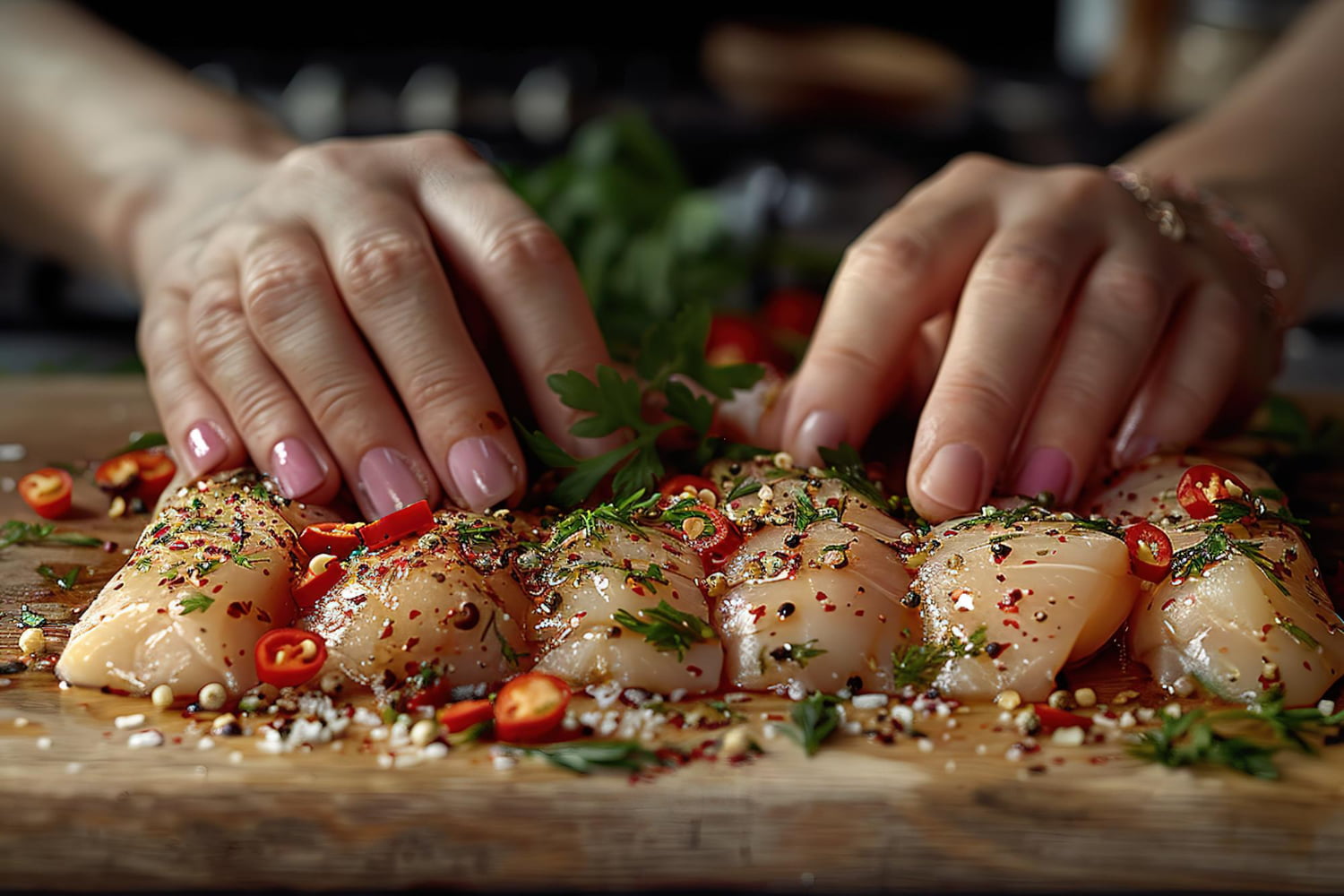Diced chicken breast is a staple in many kitchens, and for good reason. Knowing how to properly dice chicken can make a world of difference in your cooking. Dicing chicken evenly ensures that it cooks consistently, which not only enhances the flavor but also improves the texture of dishes like stir fry, salads, and casseroles. Whether you’re a seasoned chef or just learning the basics, mastering this skill is essential for creating delicious meals.
In this article, we will provide a step-by-step guide on how to dice chicken breast, covering everything from the tools you need to the best techniques. If you’ve ever struggled with cutting chicken into neat, uniform pieces, this guide is for you. By following these tips, you’ll be able to dice chicken breast quickly and easily, making meal preparation less of a chore. Check out these quick chicken breast meal ideas that utilize diced chicken for more inspiration!
Dicing chicken breast efficiently is a valuable skill for everyone, from home cooks and busy parents to students and food enthusiasts. It allows you to prepare fresh, homemade meals that are both healthy and flavorful. With the right tools and techniques, you’ll learn to dice chicken like a pro in no time. For more cutting tips, see this guide on various cutting techniques for chicken.
Why Dicing Chicken Breast Matters
- Even Cooking: Cutting chicken into cubes of uniform size helps ensure that the chicken cooks evenly. This prevents some pieces from being overcooked while others remain raw, providing a consistent texture and taste across your dish.
- Versatility in Recipes: Diced chicken breast is incredibly versatile and can be used in a variety of dishes such as stir fry, soups, salads, and pasta. Dicing chicken can transform it into a key ingredient for both quick lunches and more elaborate meals.
- Texture and Flavor: Properly diced chicken absorbs marinades and spices better, enhancing the overall flavor and texture of your dish. Whether you’re marinating for a grill or preparing a stew, evenly diced chicken pieces soak up flavors and cook to perfection.
Essential Tools for Dicing Chicken Breast
- Sharp Chef’s Knife: A sharp knife is crucial for dicing chicken breast. It ensures clean cuts and reduces the risk of accidents. Investing in a high-quality sharp chef’s knife can make a significant difference in your kitchen experience.
- Cutting Board: A sturdy cutting board prevents slipping and provides a safe surface for cutting. Opt for a non-porous board like plastic or bamboo, which is easier to clean and sanitize, especially after handling raw chicken.
- Kitchen Shears (Optional): These can be useful for trimming fat or cutting small pieces. Kitchen shears offer greater control and are particularly handy when dealing with intricate cuts.
- Paper Towels: Use paper towels to pat the chicken dry before cutting. A dry chicken breast is easier to handle and less slippery, allowing for more accurate and safer cuts.
- Food Safety Gloves (Optional): Wearing gloves can help maintain hygiene when handling raw chicken, reducing the risk of cross-contamination.
Preparing the Chicken Breast
- Start with Boneless, Skinless Chicken Breasts: Using boneless, skinless chicken breasts makes the cutting process easier and the meal healthier. This eliminates the need to trim away bones or skin, saving time and effort.
- Pat the Chicken Dry: Use paper towels to pat the chicken dry before dicing. A dry surface is less slippery, providing better control when cutting and making it easier to achieve clean, precise cuts.
- Trim Excess Fat: Use a knife or kitchen shears to trim any visible fat from the chicken breast. This step helps create cleaner, leaner pieces, improving the texture and healthiness of your meal.
- Optional Freezing Step: Partially freezing the chicken breast for 15-20 minutes can firm it up, making it easier to slice into even pieces. This is particularly helpful for those who are new to cutting chicken or when precision is required.
Step-by-Step Guide: How to Dice Chicken Breast
1. Positioning the Chicken Breast
- Lay it Flat: Place the chicken breast flat on the cutting board. If it’s thick, consider slicing it in half horizontally to create two thinner chicken cutlets before dicing.
- Stabilize: Use your non-dominant hand to hold the chicken steady. Keep your fingers curled under to avoid cutting yourself, ensuring safety and control.
2. Slicing the Chicken Breast
- Make Lengthwise Cuts: Slice the chicken breast lengthwise into strips. The width of the strips can vary based on what the recipe calls for, but generally aim for 1-inch wide strips for standard dicing.
- Turn and Slice Again: Rotate the strips and cut crosswise into cubes. This method ensures even-sized pieces that will cook uniformly, providing consistent texture and flavor.
3. Dicing into Cubes
- Cut the Chicken into Uniform Cubes: After slicing the strips, turn them 90 degrees and cut into cubes of the desired size. For most recipes, 1-inch cubes are ideal, but smaller cubes can be used for quick-cooking dishes.
- Consistency is Key: Keeping the cubes consistent in size is important for even cooking. Larger cubes are suitable for grilling or stewing, while smaller cubes are perfect for stir fry and quick sautéing.
Tips and Tricks for Perfectly Diced Chicken
- Use a Sharp Knife: A dull knife can crush the chicken instead of cutting it, making the process messier and more difficult. Always ensure your knife is sharp to make clean, efficient cuts.
- Keep the Cutting Board Stable: To prevent the cutting board from slipping, place a damp towel underneath it. This adds stability and helps ensure safety during cutting.
- Practice Good Hygiene: Always wash your hands, knife, and cutting board with hot, soapy water after handling raw chicken. This practice helps prevent cross-contamination and maintains a clean cooking environment.
- Marinate for Extra Flavor: Diced chicken pieces can absorb marinades more effectively, making them perfect for flavorful dishes. Consider marinating chicken before cooking to infuse it with additional taste.
- Cook Immediately or Store Safely: If you’re not cooking the diced chicken right away, store it in the refrigerator and use it within 1-2 days. Alternatively, freeze it for longer storage, ensuring it’s well-sealed to prevent freezer burn.
Common Mistakes to Avoid When Dicing Chicken
1. Cutting with a Dull Knife:
Using a dull knife is one of the most common mistakes when dicing chicken breast. A dull blade requires more force to cut through the chicken, which not only makes the task more difficult but also significantly increases the risk of slipping and injury. When a knife is dull, it is more likely to crush the chicken rather than slice through it cleanly, resulting in jagged, uneven pieces that can affect the cooking process. A sharp knife, on the other hand, provides much better control and requires less effort to make precise cuts. Regularly sharpening your knife is a simple step that ensures safer, faster, and more efficient dicing, making your kitchen tasks smoother and reducing the risk of accidents.
2. Overcrowding the Cutting Board:
When you try to dice too many chicken breasts on the same cutting board at once, you risk losing control and precision in your cuts. Overcrowding leads to a cluttered workspace, which can make it difficult to maintain the necessary focus and technique for accurate dicing. With too many pieces on the board, you might not have enough room to maneuver your knife properly, increasing the chances of slipping or uneven cutting. Instead, work with one or two chicken breasts at a time, ensuring there is ample space on the cutting board for clear, controlled cuts. This approach helps maintain consistency in the size of the pieces and keeps the work area tidy and safe.
3. Not Drying the Chicken:
Handling wet chicken can be a slippery and frustrating experience, making it challenging to achieve the even cuts necessary for uniform cooking. Wet chicken is more prone to sliding around on the cutting board, which can lead to uneven pieces and increase the risk of accidental slips. To avoid this, always use paper towels to pat the chicken dry before you start dicing. This step not only improves your grip on the chicken but also makes the cutting process smoother and more precise. By ensuring the chicken is dry, you gain better control and can execute clean, accurate cuts.
4. Ignoring Food Safety:
Food safety is paramount when handling raw chicken, and neglecting proper hygiene practices can lead to the spread of harmful bacteria like salmonella. After handling raw chicken, it is crucial to wash your hands thoroughly with soap and warm water. Additionally, clean the knife, cutting board, and any other utensils that came into contact with the chicken using hot, soapy water. Sanitizing your workspace reduces the risk of cross-contamination and keeps your kitchen environment safe. Always prioritize food safety by adhering to these practices, ensuring that your meals are not only delicious but also safe to eat.
By avoiding these common mistakes and following best practices for dicing chicken, you can improve your kitchen skills, enhance the flavor and texture of your dishes, and ensure a safer cooking environment.
Knowing how to dice chicken breast properly for various recipes is a valuable skill that can make meal preparation faster, easier, and more efficient. Dicing chicken breast enhances the texture and flavor of many dishes, making it a must-have technique for home cooks.Practice these techniques to become more comfortable with dicing chicken breast. With a bit of practice, your knife skills will improve, making you more efficient and confident in the kitchen.Try out some of the recipes mentioned in this article and explore other chicken recipes on our blog. Share your own tips or favorite ways to use diced chicken breast in the comments section.

